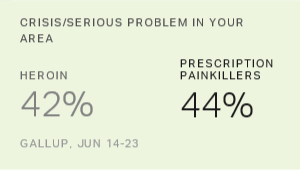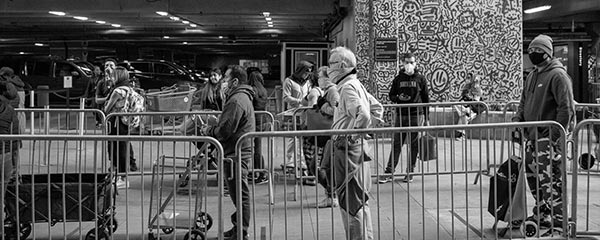Story Highlights
- 44% say prescription painkillers a crisis/very serious problem in their area
- 42% say the same for heroin
- Both seen as more serious than tobacco, cocaine, alcohol and marijuana
WASHINGTON, D.C. -- More than four in 10 Americans see prescription painkillers and heroin as a "crisis" or "very serious problem" in their local areas. Smaller percentages of Americans -- one in three or fewer -- view cigarettes, alcohol, cocaine and marijuana as a crisis or very serious problem where they live.
| Crisis | Very serious problem | Somewhat of a problem | Not much of a problem | Total: Crisis/Very serious | |||||||||||||||||||||||||||||||||||||||||||||||||||||||||||||||||||||||||||||||||||||||||||||||
|---|---|---|---|---|---|---|---|---|---|---|---|---|---|---|---|---|---|---|---|---|---|---|---|---|---|---|---|---|---|---|---|---|---|---|---|---|---|---|---|---|---|---|---|---|---|---|---|---|---|---|---|---|---|---|---|---|---|---|---|---|---|---|---|---|---|---|---|---|---|---|---|---|---|---|---|---|---|---|---|---|---|---|---|---|---|---|---|---|---|---|---|---|---|---|---|---|---|---|---|
| % | % | % | % | ||||||||||||||||||||||||||||||||||||||||||||||||||||||||||||||||||||||||||||||||||||||||||||||||
| Prescription painkillers | 14 | 30 | 28 | 24 | 44 | ||||||||||||||||||||||||||||||||||||||||||||||||||||||||||||||||||||||||||||||||||||||||||||||
| Heroin | 17 | 25 | 22 | 29 | 42 | ||||||||||||||||||||||||||||||||||||||||||||||||||||||||||||||||||||||||||||||||||||||||||||||
| Cigarettes | 10 | 23 | 33 | 33 | 33 | ||||||||||||||||||||||||||||||||||||||||||||||||||||||||||||||||||||||||||||||||||||||||||||||
| Alcohol | 8 | 24 | 35 | 32 | 32 | ||||||||||||||||||||||||||||||||||||||||||||||||||||||||||||||||||||||||||||||||||||||||||||||
| Cocaine | 8 | 20 | 29 | 37 | 28 | ||||||||||||||||||||||||||||||||||||||||||||||||||||||||||||||||||||||||||||||||||||||||||||||
| Marijuana | 6 | 17 | 25 | 50 | 23 | ||||||||||||||||||||||||||||||||||||||||||||||||||||||||||||||||||||||||||||||||||||||||||||||
| Gallup, June 14-23, 2016 | |||||||||||||||||||||||||||||||||||||||||||||||||||||||||||||||||||||||||||||||||||||||||||||||||||
These data are based on a Gallup poll conducted June 14-23, before national and state leaders took steps this month to address the growing issue of prescription painkiller and heroin abuse. In a rare display of bipartisanship, Congress passed and President Barack Obama signed the Comprehensive Addiction and Recovery Act (CARA), which contains numerous prevention and treatment measures intended to reduce prescription opioid and heroin abuse.
Additionally, 46 state and U.S. territorial governors signed a pact through the National Governors Association committing themselves to reduce inappropriate prescribing of prescription painkillers, educate the public about opioid abuse and improve access to treatment.
Across key U.S. subgroups, there are notable differences in perceptions of opioids as a crisis or very serious problem:
- Women are slightly more likely than men to say prescription painkillers are a crisis or very serious problem in their area, 48% vs. 38%, respectively. The two groups are about equally likely to say heroin is a crisis or very serious problem.
- Those living in the East (59%) are much more likely than those in other regions to say heroin is a very serious problem or crisis, with those in the South having the least concern (33%). The regional differences are much smaller on views of prescription painkillers.
- Whites are more likely than nonwhites to see heroin as a problem in their area, 46% vs. 34%, respectively, but these groups' views of prescription painkillers are similar.
- Lower-income Americans are much less likely than those living in middle- and upper-income households to see prescription painkillers as a crisis or very serious problem where they live.
- Republicans are a bit more likely than Democrats to see prescription painkillers and heroin as a crisis or very serious, but these party differences are minor in comparison to those seen on many issues Gallup measures.
| Prescription painkillers | Heroin | ||||||||||||||||||||||||||||||||||||||||||||||||||||||||||||||||||||||||||||||||||||||||||||||||||
|---|---|---|---|---|---|---|---|---|---|---|---|---|---|---|---|---|---|---|---|---|---|---|---|---|---|---|---|---|---|---|---|---|---|---|---|---|---|---|---|---|---|---|---|---|---|---|---|---|---|---|---|---|---|---|---|---|---|---|---|---|---|---|---|---|---|---|---|---|---|---|---|---|---|---|---|---|---|---|---|---|---|---|---|---|---|---|---|---|---|---|---|---|---|---|---|---|---|---|---|
| % | % | ||||||||||||||||||||||||||||||||||||||||||||||||||||||||||||||||||||||||||||||||||||||||||||||||||
| Men | 38 | 41 | |||||||||||||||||||||||||||||||||||||||||||||||||||||||||||||||||||||||||||||||||||||||||||||||||
| Women | 48 | 43 | |||||||||||||||||||||||||||||||||||||||||||||||||||||||||||||||||||||||||||||||||||||||||||||||||
| East | 48 | 59 | |||||||||||||||||||||||||||||||||||||||||||||||||||||||||||||||||||||||||||||||||||||||||||||||||
| Midwest | 41 | 43 | |||||||||||||||||||||||||||||||||||||||||||||||||||||||||||||||||||||||||||||||||||||||||||||||||
| South | 40 | 33 | |||||||||||||||||||||||||||||||||||||||||||||||||||||||||||||||||||||||||||||||||||||||||||||||||
| West | 45 | 41 | |||||||||||||||||||||||||||||||||||||||||||||||||||||||||||||||||||||||||||||||||||||||||||||||||
| Whites | 45 | 46 | |||||||||||||||||||||||||||||||||||||||||||||||||||||||||||||||||||||||||||||||||||||||||||||||||
| Nonwhites | 40 | 34 | |||||||||||||||||||||||||||||||||||||||||||||||||||||||||||||||||||||||||||||||||||||||||||||||||
| Less than $36,000 | 30 | 41 | |||||||||||||||||||||||||||||||||||||||||||||||||||||||||||||||||||||||||||||||||||||||||||||||||
| $36,000 to $89,999 | 47 | 44 | |||||||||||||||||||||||||||||||||||||||||||||||||||||||||||||||||||||||||||||||||||||||||||||||||
| $90,000+ | 47 | 41 | |||||||||||||||||||||||||||||||||||||||||||||||||||||||||||||||||||||||||||||||||||||||||||||||||
| Democrats | 43 | 38 | |||||||||||||||||||||||||||||||||||||||||||||||||||||||||||||||||||||||||||||||||||||||||||||||||
| Independents | 39 | 43 | |||||||||||||||||||||||||||||||||||||||||||||||||||||||||||||||||||||||||||||||||||||||||||||||||
| Republicans | 48 | 46 | |||||||||||||||||||||||||||||||||||||||||||||||||||||||||||||||||||||||||||||||||||||||||||||||||
| Gallup, June 14-23, 2016 | |||||||||||||||||||||||||||||||||||||||||||||||||||||||||||||||||||||||||||||||||||||||||||||||||||
Americans See Multiple Causes of Prescription Painkiller Problem
Presidential candidates from both parties have focused on opioid addiction on the campaign trail, particularly ahead of the Republican presidential debate in New Hampshire, a state ravaged by opioid overdose deaths. Eight in 10 Americans say they have heard or read about problems with prescription opioids, including 46% who have heard or read a lot, 19% some, and 15% only a little.
Americans who have heard or read about the prescription opioid problem do not rate any of four possible causes of prescription opioid addiction higher than any others, suggesting the public believes the problem needs to be attacked on multiple fronts. Slightly more than half place "a lot" of blame on "the pharmaceutical industry encouraging doctors to use opioids" and on "doctors overprescribing painkillers to their patients." Meanwhile, slightly less than half attribute a lot of the blame to a "lack of public knowledge about the dangers of opioids" and to "patients demanding that they be given a prescription to ease their pain."
| A lot | Some | Only a little | Not at all | ||||||||||||||||||||||||||||||||||||||||||||||||||||||||||||||||||||||||||||||||||||||||||||||||
|---|---|---|---|---|---|---|---|---|---|---|---|---|---|---|---|---|---|---|---|---|---|---|---|---|---|---|---|---|---|---|---|---|---|---|---|---|---|---|---|---|---|---|---|---|---|---|---|---|---|---|---|---|---|---|---|---|---|---|---|---|---|---|---|---|---|---|---|---|---|---|---|---|---|---|---|---|---|---|---|---|---|---|---|---|---|---|---|---|---|---|---|---|---|---|---|---|---|---|---|
| % | % | % | % | ||||||||||||||||||||||||||||||||||||||||||||||||||||||||||||||||||||||||||||||||||||||||||||||||
| The pharmaceutical industry encouraging doctors to use opioids | 55 | 22 | 13 | 7 | |||||||||||||||||||||||||||||||||||||||||||||||||||||||||||||||||||||||||||||||||||||||||||||||
| Doctors overprescribing painkillers to their patients | 53 | 27 | 14 | 5 | |||||||||||||||||||||||||||||||||||||||||||||||||||||||||||||||||||||||||||||||||||||||||||||||
| Lack of public knowledge about the dangers of opioids | 49 | 28 | 14 | 8 | |||||||||||||||||||||||||||||||||||||||||||||||||||||||||||||||||||||||||||||||||||||||||||||||
| Patients demanding that they be given a prescription to ease their pain | 47 | 29 | 16 | 5 | |||||||||||||||||||||||||||||||||||||||||||||||||||||||||||||||||||||||||||||||||||||||||||||||
| Among those who have heard at least a little about opioid problem | |||||||||||||||||||||||||||||||||||||||||||||||||||||||||||||||||||||||||||||||||||||||||||||||||||
| Gallup, June 14-23, 2016 | |||||||||||||||||||||||||||||||||||||||||||||||||||||||||||||||||||||||||||||||||||||||||||||||||||
Among those who have heard or read about the prescription opioid problem, Republicans are less likely than Democrats to blame pharmaceutical companies and lack of public knowledge about opioids for addiction problems. Republicans are more likely than Democrats to blame patients demanding that they be given prescription painkillers. Both are just as likely to blame doctors for overprescribing painkillers.
| Democrats | Republicans | Independents | |||||||||||||||||||||||||||||||||||||||||||||||||||||||||||||||||||||||||||||||||||||||||||||||||
|---|---|---|---|---|---|---|---|---|---|---|---|---|---|---|---|---|---|---|---|---|---|---|---|---|---|---|---|---|---|---|---|---|---|---|---|---|---|---|---|---|---|---|---|---|---|---|---|---|---|---|---|---|---|---|---|---|---|---|---|---|---|---|---|---|---|---|---|---|---|---|---|---|---|---|---|---|---|---|---|---|---|---|---|---|---|---|---|---|---|---|---|---|---|---|---|---|---|---|---|
| % | % | % | |||||||||||||||||||||||||||||||||||||||||||||||||||||||||||||||||||||||||||||||||||||||||||||||||
| The pharmaceutical industry encouraging doctors to use opioids | 57 | 47 | 60 | ||||||||||||||||||||||||||||||||||||||||||||||||||||||||||||||||||||||||||||||||||||||||||||||||
| Doctors overprescribing painkillers to their patients | 47 | 49 | 60 | ||||||||||||||||||||||||||||||||||||||||||||||||||||||||||||||||||||||||||||||||||||||||||||||||
| Lack of public knowledge about the dangers of opioids | 53 | 41 | 52 | ||||||||||||||||||||||||||||||||||||||||||||||||||||||||||||||||||||||||||||||||||||||||||||||||
| Patients demanding that they be given a prescription to ease their pain | 40 | 52 | 49 | ||||||||||||||||||||||||||||||||||||||||||||||||||||||||||||||||||||||||||||||||||||||||||||||||
| Gallup, June 14-23, 2016 | |||||||||||||||||||||||||||||||||||||||||||||||||||||||||||||||||||||||||||||||||||||||||||||||||||
Bottom Line
More Americans see prescription painkillers and heroin as a crisis or very serious problem in their area than do so for any of the other four items Gallup asked about. Americans are also significantly more worried about drugs as a problem facing the country more broadly now than in recent years. In March, Gallup found 44% of Americans worry about drug use "a great deal," up 10 percentage points from two years ago.
The new federal opioid law and the pact that nearly all state governors signed address some of the factors Americans say are to blame for the opioid problem. The federal law encourages states to establish programs to monitor drug prescriptions, and the pact includes measures to reduce inappropriate prescribing of painkillers. Both feature public education components to increase awareness of the dangers of opioids. The federal law also establishes a task force for studying how to better address pain and offers incentives for pharmaceutical companies to develop non-opioid painkillers. However, Obama and congressional Democrats argue that the law does not provide enough funding to prevent and treat opioid abuse and addiction.
The outcome of the presidential election also could shape how opioid addiction will be addressed in the coming years. Hillary Clinton released a $10 billion plan last year that expands access to treatment programs. Donald Trump has said building a wall on the border between the U.S. and Mexico will keep drugs out of the country but hasn't offered other specifics on how to prevent or treat abuse and addiction.
Historical data are available in Gallup Analytics.
Survey Methods
Results for this Gallup poll are based on telephone interviews conducted June 14-23, 2016, with a random sample of 1,025 adults, aged 18 and older, living in all 50 U.S. states and the District of Columbia. For results based on the total sample of national adults, the margin of sampling error is ±4 percentage points at the 95% confidence level.
Each sample of national adults includes a minimum quota of 60% cellphone respondents and 40% landline respondents, with additional minimum quotas by time zone within region. Landline and cellular telephone numbers are selected using random-digit-dial methods.
View survey methodology, complete question responses and trends.
Learn more about how the Gallup Poll Social Series works.


